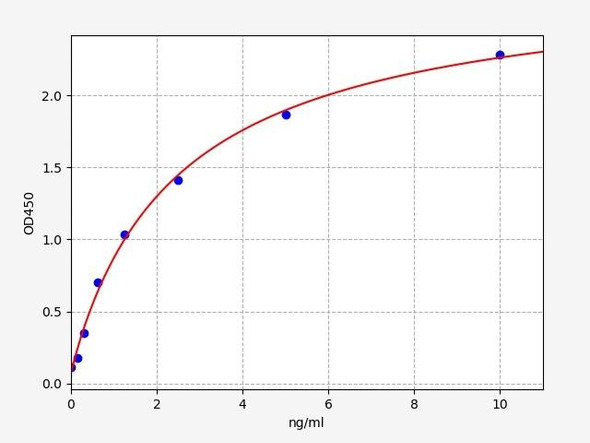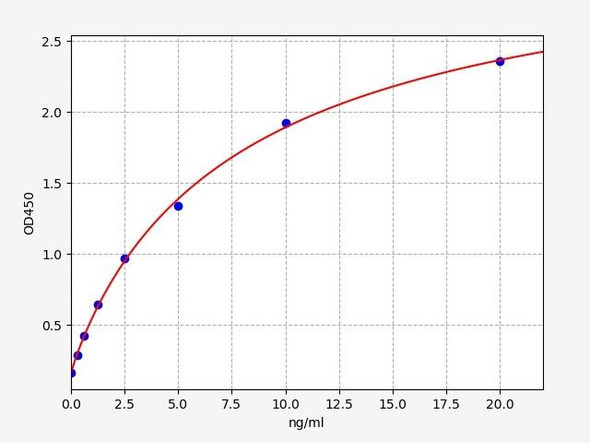Rat Aquaporin-4 (Aqp4) ELISA Kit (RTEB0353)
- SKU:
- RTEB0353
- Product Type:
- ELISA Kit
- Size:
- 96 Assays
- Uniprot:
- P47863
- Range:
- 0.156-10 ng/mL
- ELISA Type:
- Sandwich
- Synonyms:
- AQP-4, Aquaporin-4, AQP4, HMIWC2, MIWC, WCH4
- Reactivity:
- Rat
Description
Rat Aquaporin-4 (Aqp4) ELISA Kit
The Rat Aquaporin-4 (AQP4) ELISA Kit is a highly accurate and sensitive assay designed for the precise detection of Aquaporin-4 levels in rat serum, plasma, and cell culture supernatants. This kit ensures reliable and reproducible results, making it ideal for various research applications.Aquaporin-4 is an important water channel protein that plays a crucial role in water transportation in the central nervous system. Dysregulation of AQP4 has been linked to various neurological disorders, including multiple sclerosis and neuromyelitis optica.
Studying AQP4 levels can provide valuable insights into the pathophysiology of these conditions and aid in the development of potential therapeutic interventions.The Rat Aquaporin-4 (AQP4) ELISA Kit offers a convenient and efficient solution for researchers looking to investigate the role of AQP4 in neurological diseases and other related conditions. With its high sensitivity and specificity, this kit ensures accurate measurement of AQP4 levels, allowing for precise and reliable data analysis.
| Product Name: | Rat Aquaporin-4 (Aqp4) ELISA Kit |
| SKU: | RTEB0353 |
| Size: | 96T |
| Target: | Rat Aquaporin-4 (Aqp4) |
| Synonyms: | Mercurial-insensitive water channel, WCH4, MIWC, AQP-4 |
| Assay Type: | Sandwich |
| Detection Method: | ELISA |
| Reactivity: | Rat |
| Detection Range: | 0.156-10ng/mL |
| Sensitivity: | 0.078ng/mL |
| Intra CV: | 6.1% | ||||||||||||||||||||
| Inter CV: | 9.3% | ||||||||||||||||||||
| Linearity: |
| ||||||||||||||||||||
| Recovery: |
| ||||||||||||||||||||
| Function: | Forms a water-specific channel. Osmoreceptor which regulates body water balance and mediates water flow within the central nervous system. It is expressed predominantly in the ependymal cell lining the aqueductal system and over the space of the brain in contact with the subarachnoid space, as cerebrospinal fluid fills these structures it may facilitate water balance between brain parenchyma and the fluid compartment. In the plasma membranes of the neurons of the paraventricular and supraoptic nuclei, it may mediate rapid changes in cell volume in response to local shifts in extracellular osmolarity. |
| Uniprot: | P47863 |
| Sample Type: | Serum, plasma, tissue homogenates, cell culture supernates and other biological fluids |
| Specificity: | Natural and recombinant rat Aquaporin-4 |
| Sub Unit: | Homotetramer. Part of a complex containing MLC1, TRPV4, HEPACAM and ATP1B1. |
| Subcellular Location: | Membrane Multi-pass membrane protein |
| Storage: | Please see kit components below for exact storage details |
| Note: | For research use only |
| UniProt Protein Function: | AQP4: a member of the aquaporin family of intrinsic membrane proteins that function as water-selective channels in the plasma membranes of many cells. The predominant aquaporin found in brain. Two alternatively spliced transcript variants have been described |
| UniProt Protein Details: | Protein type:Channel, misc.; Membrane protein, multi-pass; Transporter, aquaporin family; Transporter; Membrane protein, integral Cellular Component: basal plasma membrane; basolateral plasma membrane; cell projection membrane; cytoplasm; external side of plasma membrane; integral to membrane; integral to plasma membrane; intercellular junction; membrane; plasma membrane; pore complex; protein complex; sarcolemma; T-tubule Molecular Function:glycerol channel activity; porin activity; transporter activity; water channel activity Biological Process: carbon dioxide transport; female pregnancy; glycerol transport; hyperosmotic salinity response; multicellular organismal water homeostasis; negative regulation of interleukin-1 beta production; negative regulation of interleukin-6 production; protein homooligomerization; response to glucocorticoid stimulus; response to radiation; sensory perception of sound; transmembrane transport; transport; water homeostasis; water transport |
| NCBI Summary: | This gene encodes a member of the aquaporin family of intrinsic membrane proteins that function as water-selective channels in the plasma membranes of many cells. This protein is the predominant aquaporin found in brain and has an important role in brain water homeostasis. Alternatively spliced transcript variants encoding different isoforms have been described for this gene. A recent study provided evidence for translational readthrough in this gene and expression of an additional C-terminally extended isoform via the use of an alternative in-frame translation termination codon. [provided by RefSeq, Dec 2015] |
| UniProt Code: | P47863 |
| NCBI GenInfo Identifier: | 395759219 |
| NCBI Gene ID: | 25293 |
| NCBI Accession: | NP_001257487.1 |
| UniProt Related Accession: | P47863 |
| Molecular Weight: | 28,768 Da |
| NCBI Full Name: | aquaporin-4 isoform 3 |
| NCBI Synonym Full Names: | aquaporin 4 |
| NCBI Official Symbol: | Aqp4 |
| NCBI Official Synonym Symbols: | Miwc; WCH4; AQP-4 |
| NCBI Protein Information: | aquaporin-4 |
| UniProt Protein Name: | Aquaporin-4 |
| UniProt Synonym Protein Names: | Mercurial-insensitive water channel; MIWC; WCH4 |
| Protein Family: | Aquaporin |
| UniProt Gene Name: | Aqp4 |
| UniProt Entry Name: | AQP4_RAT |
| Component | Quantity (96 Assays) | Storage |
| ELISA Microplate (Dismountable) | 8×12 strips | -20°C |
| Lyophilized Standard | 2 | -20°C |
| Sample Diluent | 20ml | -20°C |
| Assay Diluent A | 10mL | -20°C |
| Assay Diluent B | 10mL | -20°C |
| Detection Reagent A | 120µL | -20°C |
| Detection Reagent B | 120µL | -20°C |
| Wash Buffer | 30mL | 4°C |
| Substrate | 10mL | 4°C |
| Stop Solution | 10mL | 4°C |
| Plate Sealer | 5 | - |
Other materials and equipment required:
- Microplate reader with 450 nm wavelength filter
- Multichannel Pipette, Pipette, microcentrifuge tubes and disposable pipette tips
- Incubator
- Deionized or distilled water
- Absorbent paper
- Buffer resevoir
*Note: The below protocol is a sample protocol. Protocols are specific to each batch/lot. For the correct instructions please follow the protocol included in your kit.
Allow all reagents to reach room temperature (Please do not dissolve the reagents at 37°C directly). All the reagents should be mixed thoroughly by gently swirling before pipetting. Avoid foaming. Keep appropriate numbers of strips for 1 experiment and remove extra strips from microtiter plate. Removed strips should be resealed and stored at -20°C until the kits expiry date. Prepare all reagents, working standards and samples as directed in the previous sections. Please predict the concentration before assaying. If values for these are not within the range of the standard curve, users must determine the optimal sample dilutions for their experiments. We recommend running all samples in duplicate.
| Step | |
| 1. | Add Sample: Add 100µL of Standard, Blank, or Sample per well. The blank well is added with Sample diluent. Solutions are added to the bottom of micro ELISA plate well, avoid inside wall touching and foaming as possible. Mix it gently. Cover the plate with sealer we provided. Incubate for 120 minutes at 37°C. |
| 2. | Remove the liquid from each well, don't wash. Add 100µL of Detection Reagent A working solution to each well. Cover with the Plate sealer. Gently tap the plate to ensure thorough mixing. Incubate for 1 hour at 37°C. Note: if Detection Reagent A appears cloudy warm to room temperature until solution is uniform. |
| 3. | Aspirate each well and wash, repeating the process three times. Wash by filling each well with Wash Buffer (approximately 400µL) (a squirt bottle, multi-channel pipette,manifold dispenser or automated washer are needed). Complete removal of liquid at each step is essential. After the last wash, completely remove remaining Wash Buffer by aspirating or decanting. Invert the plate and pat it against thick clean absorbent paper. |
| 4. | Add 100µL of Detection Reagent B working solution to each well. Cover with the Plate sealer. Incubate for 60 minutes at 37°C. |
| 5. | Repeat the wash process for five times as conducted in step 3. |
| 6. | Add 90µL of Substrate Solution to each well. Cover with a new Plate sealer and incubate for 10-20 minutes at 37°C. Protect the plate from light. The reaction time can be shortened or extended according to the actual color change, but this should not exceed more than 30 minutes. When apparent gradient appears in standard wells, user should terminatethe reaction. |
| 7. | Add 50µL of Stop Solution to each well. If color change does not appear uniform, gently tap the plate to ensure thorough mixing. |
| 8. | Determine the optical density (OD value) of each well at once, using a micro-plate reader set to 450 nm. User should open the micro-plate reader in advance, preheat the instrument, and set the testing parameters. |
| 9. | After experiment, store all reagents according to the specified storage temperature respectively until their expiry. |
When carrying out an ELISA assay it is important to prepare your samples in order to achieve the best possible results. Below we have a list of procedures for the preparation of samples for different sample types.
| Sample Type | Protocol |
| Serum | If using serum separator tubes, allow samples to clot for 30 minutes at room temperature. Centrifuge for 10 minutes at 1,000x g. Collect the serum fraction and assay promptly or aliquot and store the samples at -80°C. Avoid multiple freeze-thaw cycles. If serum separator tubes are not being used, allow samples to clot overnight at 2-8°C. Centrifuge for 10 minutes at 1,000x g. Remove serum and assay promptly or aliquot and store the samples at -80°C. Avoid multiple freeze-thaw cycles. |
| Plasma | Collect plasma using EDTA or heparin as an anticoagulant. Centrifuge samples at 4°C for 15 mins at 1000 × g within 30 mins of collection. Collect the plasma fraction and assay promptly or aliquot and store the samples at -80°C. Avoid multiple freeze-thaw cycles. Note: Over haemolysed samples are not suitable for use with this kit. |
| Urine & Cerebrospinal Fluid | Collect the urine (mid-stream) in a sterile container, centrifuge for 20 mins at 2000-3000 rpm. Remove supernatant and assay immediately. If any precipitation is detected, repeat the centrifugation step. A similar protocol can be used for cerebrospinal fluid. |
| Cell culture supernatant | Collect the cell culture media by pipette, followed by centrifugation at 4°C for 20 mins at 1500 rpm. Collect the clear supernatant and assay immediately. |
| Cell lysates | Solubilize cells in lysis buffer and allow to sit on ice for 30 minutes. Centrifuge tubes at 14,000 x g for 5 minutes to remove insoluble material. Aliquot the supernatant into a new tube and discard the remaining whole cell extract. Quantify total protein concentration using a total protein assay. Assay immediately or aliquot and store at ≤ -20 °C. |
| Tissue homogenates | The preparation of tissue homogenates will vary depending upon tissue type. Rinse tissue with 1X PBS to remove excess blood & homogenize in 20ml of 1X PBS (including protease inhibitors) and store overnight at ≤ -20°C. Two freeze-thaw cycles are required to break the cell membranes. To further disrupt the cell membranes you can sonicate the samples. Centrifuge homogenates for 5 mins at 5000xg. Remove the supernatant and assay immediately or aliquot and store at -20°C or -80°C. |
| Tissue lysates | Rinse tissue with PBS, cut into 1-2 mm pieces, and homogenize with a tissue homogenizer in PBS. Add an equal volume of RIPA buffer containing protease inhibitors and lyse tissues at room temperature for 30 minutes with gentle agitation. Centrifuge to remove debris. Quantify total protein concentration using a total protein assay. Assay immediately or aliquot and store at ≤ -20 °C. |
| Breast Milk | Collect milk samples and centrifuge at 10,000 x g for 60 min at 4°C. Aliquot the supernatant and assay. For long term use, store samples at -80°C. Minimize freeze/thaw cycles. |










